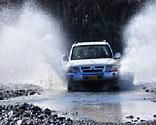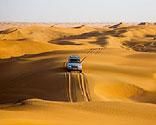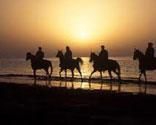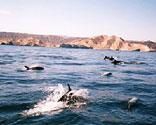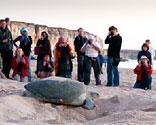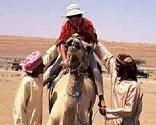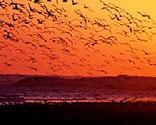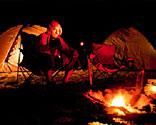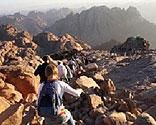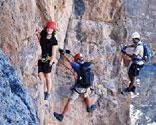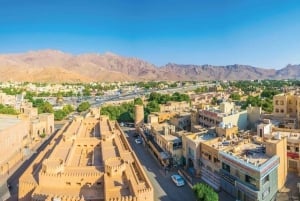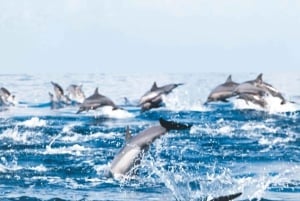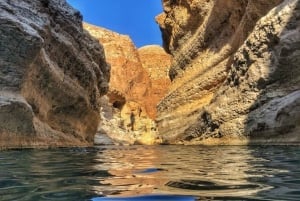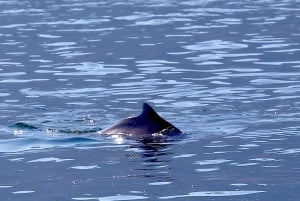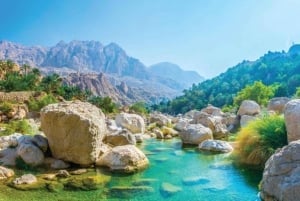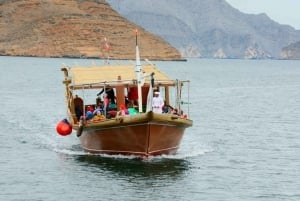Favourite Things to Do
Dolphin Watching
Dolphin watching is a popular activity available through many tour operators in Oman such as Marina Banda Al Rowda, Oman Dive Centre and Arabian Sea Safaris. There is something very special about sailing alongside a school of playful dolphins and while it cannot be guaranteed that you will see any during a tour, it is more than likely that you will. Over 20 types of whales and dolphins have been identified in the areas off the coast of Oman. You are more likely to see dolphins in the cooler months, from October to May and whales are best spotted early morning and evening. A knowledgeable and responsible operator will enhance your experience and protect the sea life.
The Whale and Dolphin Research Group, part of the Environment Society of Oman (ESO) is a group of scientists and volunteers, who monitor, protect and collect information about Oman’s whales and dolphins and their environment. The group is involved in emergency rescue services for these animals and the upkeep of a database recording sightings and stranded animals. The group is active in promoting responsible whale and dolphin activities and volunteers are always well received for fundraising events.
Masjed Tour
Masjed (Mosques) are naturally omnipotent in the landscape of Muslim Oman and while many are beautiful to admire from the outside, only one is officially available for visitors to tour inside. The Sultan Qaboos Grand Mosque and its lush palm gardens appear in perfect view as you head towards Al Ghubra from the airport. It is spectacular in its Islamic architecture and heaven for the photographer. A knowledgeable guide will bombard you with facts and figures of the breath-taking interior and answer any questions you may have relating to Islam. It’s highest minaret reaches nearly 100m and it is also one of the largest in the Arab region. Adjacent is a separate, smaller mosque for women. This mosque is also important for housing an Islamic reference library containing a vast amount of information on Islamic science and culture.
Strict rules regarding attire and opening times apply: non-Muslim visitors may only visit between the hours of 8.30 and 11.00am Saturday to Thursday. Women especially should dress respectfully and be covered from head to foot (except face). An abaya would be suitable attire. Children aged ten and above are also allowed entry. An information centre is available on the site for those seeking further information.
Camping
Spending a night under the stars is perhaps one of the most beautiful things you can do to experience every facet of Oman.
Now, there is camping and there is glamping. The former involves you setting up your own camp, and cooking your meals by moonlight while the latter is a luxurious version of nomadic living.
You can camp pretty much anywhere you fancy; on one of the long sandy beaches, up in the mountains or in the desert. It really depends on whether you wish to spend your time hiking over rocky terrains or making sandcastles, when you wake up.
Some popular beaches for camping are: White Beach, Tiwi and the east coast sands between Al Ashkhara and Ras Al Ruwais.
While temperatures are cooler in the mountains and during the winter nights everywhere, you will not need Arctic quality camping equipment, just a good sleeping bag and a lightweight tent. And a few extra layers for sitting round the campfire.
The glamping experience can be had in Bedouin style wool tents with all mod cons, at various desert camps in the Wahiba Sands. Check out 1000 Nights and Al Areesh camp. Air-conditioned luxury awaits you at Jebal Shams and the Al Naseem camp is right next to the Ras Al Jinz nature reserve.
You will need to take all the usual basic safety equipment as you may be a long way from the nearest shop or medical facility.
Please be a responsible camper and take all your rubbish away with you!
Wadi Bashing
One way of experiencing Oman’s geography is to venture out on a wadi bashing trip. This involves careering through the uneven terrain of the wadi (dry river bed) in a 4x4, avoiding pitfalls such as soft ground and boulders. Some careful navigating will take you through narrow rock-filled tracks and alongside beautiful freshwater pools, perfect for a refreshing dip. You may come across ancient falaj systems (irrigation channels) streams and terraced mountainsides, used for growing crops. Keep an eye out for picturesque picnic spots and shady rest areas, to avoid the midday sun.
Some good spots for wadi bashing are Wadi Shab, WadiTiwi, Wadi Bani Awf and Wadi Bani Khalid.
It goes without saying that safety comes first, so follow the basic rules for a safe trip: always travel in a convoy, carry basic first aid equipment, a mobile phone, plenty of water and some food, wear practical clothing and footwear, a hat and sunscreen.
You should also advise people of your adventure plans and your estimated time of return.
Check the weather forecast before you set off on your journey as you don’t want to be caught up in a flash flood.
Turtle Watching
Oman’s waters are home to five out of the seven recognised species of marine turtle and some of the World’s most important nesting beaches are situated in Oman. Turtles are found on around 275 beaches in Oman and breeding reserves are located in the Damaniyat islands, Ras Al Jinz, Masirah and Ras Al Hadd.To see a giant turtle lay her eggs on a beach in the dim light of dawn or in the middle of the night is a magical moment and you can experience this in a number carefully managed locations. Conservation of the turtles’ nesting sites is of utmost importance in Oman and you will require a permit and a guide to take you to see the turtles in action.
Ras Al Jinz Sea Turtle and Nature Reserve has a Scientific and Visitor Centre and also houses a marine biology and archaeology research centre.
There are various types of accommodation available in the areas from campsites to basic air-conditioned rooms. The Turtle Beach Resort at Ras Al Hadd provides lunch and dinner and has 32 cottages with beds.
Hiking/Trekking
As rock climbing also demonstrates, Oman’s mountainous regions are often best explored on foot to appreciate hidden views of the spectacular scenery. October to April is the best time to go trekking due to the beautiful weather conditions. Your experienced guide will be able to explain the different rock formations to you and how they were formed. Treks are available for every level of ability and tour operators can organise everything from a short walk in the wadis to a trek to the top of Jebal Akhdar, 2,400km above sea level. One of the most popular walks is the Jebel Shams rim walk but it is only suitable for the very fit as the conditions are physically demanding.
Gulf Leisure, Muscat Dive and Adventure Centre and Oman Trekking Guides (Nizwa Tour guides) have a variety of itineraries to suit everyone.
Walks can take you through living or abandoned villages, date palm plantations and falaj systems and you can view the breath-taking ‘Grand Canyon’ of the Hajar Mountain range. You may even meet some of the friendly local people as you explore the area. Safety basics (appropriate clothing, sunscreen, water, mobile phone, first aid kit) are essential.
Camel Riding/Racing
The national sport of camel racing is centuries old and is extremely popular to this day. Omani Bedouin families still breed, raise and train the camels for racing and Omani camels are considered the best in the business. Races are typically spread over a period of days and the racing season begins in August through to April. They are held in the early morning on Fridays and public holidays in various locations in outside the city including Seeb, the main location and also in the interior down to Salalah. The races start from 6am to 9am so you will need to get up with the birds to get a good view. The racing is fast and furious; winners receive a large prize so competition is fierce!
If you fancy experiencing a ride on the ship of the desert, you may do so with many of the tour operators in the Wahiba sands who offer this as part of the tour package. Unlike horse riding, you will mount the camel while it is sitting down and cling on as it finds its feet to a standing position. All you have to do then is hold on while a guide takes you for a walk over the sands. This is of course provides the most fantastic souvenir photo of your trip to Oman!
Diving
The waters surrounding Oman offer some of the most spectacular diving on the planet. You will also find them far less crowded than other diving areas, meaning you will see more fish than people. Another advantage is that the diving is available all throughout the year. There are a number of dive schools offering lessons, both PADI and BSAC. Blu Zone Water Sports offer a range of dive courses including ones for children aged 8 years or older. Damaniyat Divers and Global Scuba also offer courses from Bubblemaker to Dive Master. Muscat Dive and Adventure Centre have a wide variety of land and water activities worth checking out. Dive equipment can also be hired from these centres.
Experienced divers can even test their nerves with a night dive to view a whole range of nocturnal creatures and the phosphorescence (plankton, which when disturbed give the water an ethereal glow) is a magical sight. Or why not try out your skills on a cave dive? Shipwrecks and coral reefs made of many different species play host to a wide variety of marine life including turtles, stingrays moray eels, cuttlefish and reef sharks. A dive permit from the ROP is necessary and available through the dive clubs.
Desert Safari
If you are more of a thrill seeker than a sun seeker, you may wish to go on a desert safari. This involves making the most out of the steep sandy banks in a 4x4 – dune bashing! Under the expert tuition of your local guide, you will learn all the tips and tricks to tackling the desert landscape - safely, but with maximum excitement. Dune buggies are also great for flying over the soft sands.
The desert tourist camps in the Wahiba Sands cater for all elements of the desert experience, including more gentle activities such as sand-boarding and camel rides and evening entertainment such as authentic belly dancers and musicians.
The highlight for many is watching the sun set over the dunes, bringing with it a deep blue sky. Uninterrupted by electric light, millions of glittering stars light up the night sky and you can spend hours gazing up and looking for shooting stars. The sunrise is equally majestic if you are inclined to get up that early.
In contrast to the excitement of the adrenaline-fueled activities, the desert scenery is simply stunning and deafeningly tranquil. It also offers opportunities for beautiful and dramatic photographs.
Remember to pack your safety basics, especially bottled water, for the long drive to the desert.
Bird watching
Due to the intense cultivation of plants and trees in the past 30 years, the avian population in the Sultanate has dramatically risen to over 450 different species, 30 of which are native to Oman. Many of these species are migratory between Africa and Asia. Good spots to observe these birds are in lagoons such as those at Al Ansab and Qurum Natural Park. Beaches, mountains and mudflats are important sites too.
The coastal lagoons at Bar Al Hickman cover 900km2 and are of particular importance as they are a resting point for migratory birds. Huge v-shaped flocks can be seen traversing the skies above and if you are lucky enough to be camping there you will witness several species in flight.
You can hope to seeIndian rollers, little green bee-eaters, yellow-vented bulbuls, graceful prinias and purple sunbirds as well as terns, gulls and waders to name a few.
The Oman Bird Group can give you more advice on where to go twitchingor you can contact The Muscat Diving and Adventure Centre or African Sea Safaris to organise a bird watching trip. As with any off road trip, be properly prepared in terms of your equipment and supplies.
Sailing
Oman’s sailing heritage continues to flourish today, with the support of Oman Sail who are training the Omani youth to gold medal standards. The prize-winning national teams participate in regattas held locally and internationally. The sport is also open to private boat owners, who may take out a membership at the boat clubs at Capital Area Yacht Club (CAYC) or Marina Banda Al Rowda. Tour companies there can organise lessons in different types of craft, boats can be chartered with or without a driver and packages can include diving, snorkelling and dolphin watching. Fishing trips are also available, including equipment, for a few hours or a full day.
The Oman Laser Association (OLA) organises 10 competitions each year and promotes the interests of small boat and laser sailing in Oman. Races are held at various locations including Marina Bandar Al Rowda, Al Sawadi Resort and Ras Al Hamra Recreation Club.
The Offshore Sailing Owners Group promotes offshore sailing in Omani waters. The group races regularly and offers many social events for the owners, crew and their families.
Horse Riding/Racing
Horse racing is traditional in Arabic countries and Oman is renowned for its purebred Arabian horses, which are said to originate from the stallion that Prophet Solomon gave to the Azd tribe. Horse breeders in Oman have been careful to preserve pure bloodlines resulting in consistently healthy and strong animals. The Oman Equestrian Foundation was established in the ‘80s who organise show jumping events such as the Annual Royal Meeting national show jumping competition during the winter months. Every five years, the Royal Equestrian Show is held at the Enam Equestrian grounds in Seeb.
There are a number of riding schools offering lessons for new learners and the more experienced alike. Al Fursan Stables offers other services such as pleasure trips to local areas of beauty such as the beachin Shatti Al Qurum, the Qurum Nature Reserve and Qurum Garden.The Qurum Equestrian School offers a Pony Club for children and also has some donkeys for small children to ride.The school can even organise horse drawn carriages for weddings or events. In addition, it is possible to keep your own horses at some of the stables.
Rock Climbing
The geography in Oman is a treat for rock climbers and the routes provide fantastic views of the scenery. The craggy mountains, gorges, faults and steep cliffs promise an exhilarating climb for even the most experienced climbers. Established routes traverse through the mountains and are cater to various levels of climbers’ experience and fitness levels. There are three sport-climbing sites around 2.5 hours drive from Muscat.
You are advised to bring your climbing equipment with you, however it may be possible to hire equipment on an hourly or day basis. The basics can be learned on an indoor wall before beginners brave the rock face itself. Routes start off as close to Muscat as Wadi Adai, while a 4x4 is required to reach other routes such as Wadi Bani Auf, which is around two hours drive away. A short walk may also be necessary to reach the mountain routes. Deep Water Soloing (DWS) is possible for the brave-hearted.Companies such as Gulf Leisureand Muscat Diving and Adventure Centre can assist you.
Remember to take your safety basics with you, especially bottled water!



